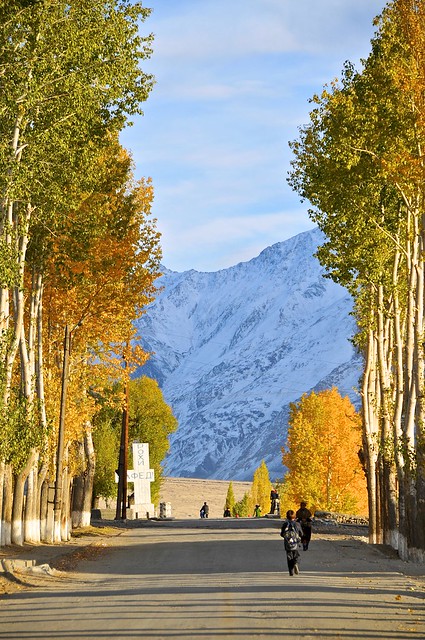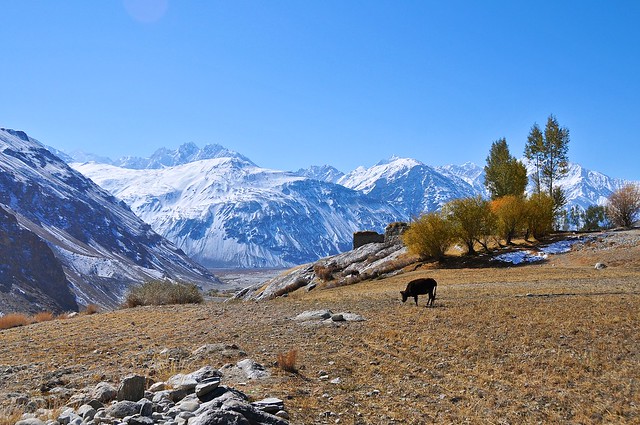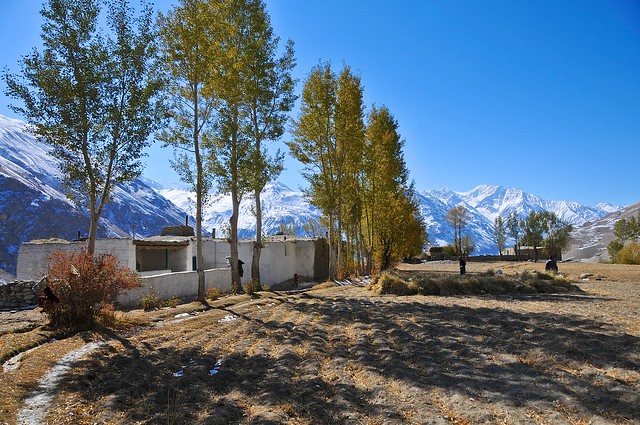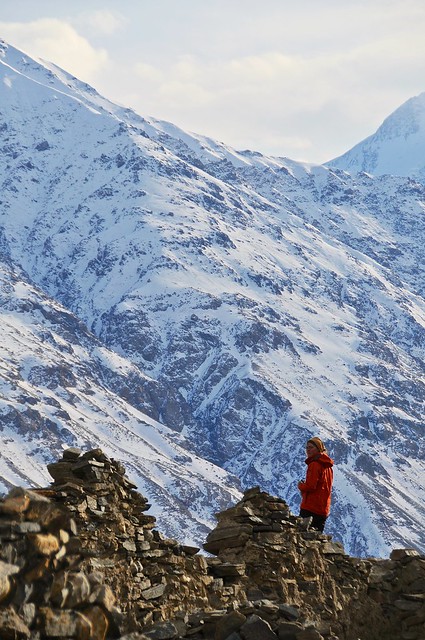The eventful ride to Langar
After getting my visa I headed over to the taxi lot for Ishkashim and Langar. Walk through one of these lots and you'll be approached by people asking where you're going, and if you're lucky they'll either be going there or point you to someone who is. Then you start negotiating price, which can be tricky for locals and foreigners alike. The general rule is that you try to get to car lots as early as possible, although when traveling from a market town to nearby rural villages most cars leave after people have had a chance to shop at the market. Ishkashim itself is probably somewhere between the two options: it's lose enough that people may drive up to Khorog in the morning for the market, but it's also big enough that it has a decent market of its own. Langar is far enough away that no one would drive to Khorog just to do shopping, however.
Despite this, and despite my not leaving until the afternoon as a result of obtaining my Afghan visa in the morning, I was able to find a vehicle going all the way to Langar, for 100 somoni.
Of course, this being rural Central Asia, things are rarely as simple as they seem. Even though the car was full, we ended up making a stop at the nearby village of Dasht, which is just above the Khorog-Ishkashim road but utterly hidden from the valley below, so that we could pick up some cargo from one of the passengers' family. We ended up staying in Dasht for fifteen minutes or so, stopping at a couple of different houses before continuing on our way. Pretty standard stuff. One of the ladies returned from one of the houses with a big bag of apples which she shared with the car.
 |
| Poplar-lined road in Dasht village, above the road to Ishkashim. |
 |
| Hay stacked precariously on the roof. |
 |
| Rooster just wandering around the village. |
 |
| A Tajik farmhouse, with Afghan mountains on the other side of the Pyanj river. |
 |
| Looking north down the Pyanj towards Khorog: Afghanistan on the left, Tajikistan on the right. |
 |
| Looking down the main street in Ishkashim, with the Hindu Kush in the background. |
When we arrived in Ishkashim, however, it became apparent that something was up. The jeep I was in was only going as far as Ishkashim, and apparently I was to join two other passengers—a young couple—on their way to Langar. That would be fine, except the girl and I ended up sitting around and waiting while the guy went around trying to arrange onward transportation. After over an hour of waiting around (this on top of the hour spent waiting for passengers in Khorog, plus the time spent in Dasht), we finally got a ride to a relative's house outside of Ishkashim, where we swapped vehicles into an older Russian sedan, and then started off again. By his time it was dark out, but I was happy that we wee finally on our way.
But we weren't on our way for long. After less than an hour of driving, we pulled over. I wasn't quite sure what was going on, but after waiting for a while they flagged down a passing jeep heading up the valley and packed the girl into it, leaving me with her boyfriend/husband and his brother/friend. Apparently the plan was now that we would spend the night at his house, and then continue to Langar in the morning. In all honesty, I would probably be OK with this most of the time, but with my Tajik visa running out, the clock ticking on my Uzbek visa, and a very limited window in which I could possibly use my Afghan visa, this was something I wasn't prepared to accept. Especially since I figured that it was extremely unlikely the supposed journey to Langar in the morning would be as quick and painless as implied, and I was kind of angry that they stuck the girl on a vehicle to Langar instead of me or both of us.
Anyway, I refused to get in the car for the ride to their house, insisting that I would rather stand by the road and try to make my way up the valley on my own. Of course this was stupid, since it was really quite cold already and would only get colder, but I was really annoyed. I mean, if they had simply told me in Khorog that this was the plan, I would have declined. And since the girl had been picked up, there clearly were other vehicles going up the valley that I could have hitched a ride with.
After a bit of pidgin negotiating, the driver called his sister who spoke English pretty well, and she translated for me. It seems that the guys thought I was worried about safety, and wanted to assure me I would be fine at their house. I explained that my visa was expiring soon and that even though it might take only an extra day to get to Langar, this was a day I didn't have. While I was talking to her, another jeep heading up the road came by and was flagged down. After a bit of talking and negotiating, I was transferred to this car, and refunded something like 30 somoni to pay for the rest of the ride. I feel kind of bad for those guys I left (especially since the language barrier made it impossible to get a firm idea of what was going on at the very beginning of the trip), but at the same time the entire situation was ridiculous. If I had stayed with them, it would have taken 20 hours to make a six hour trip.
The drive to Langar was pretty cramped, but the other passengers were very friendly. One of the guys next to me insisted on giving me his phone number despite knowing I didn't have a phone, because he wanted me to call him and stay with his family if I was passing through his village (he got out before Langar). This is pretty typical of Wakhan hospitality, and I think it's even greater if you're white or more obviously a stranger.
It was after 11:00 when we rolled into Langar, and we left the main road and detoured out through side roads that took us through fields near the river as we made our way to one of our last stops, which turned out to be a huge walled compound that obviously belonged to a prosperous family. It seemed a bit strange that they should be using public transport give the obvious wealth, but I think we mainly unloaded some cargo there. Anyway, I was a bit worried arriving in Langar so late with nowhere to stay, but when I said I wanted to be dropped off at Yodgor's (who I hoped was still awake), they knew who he was and took me there. Once we arrived, we found Yodgor awake and he came out to greet us. Yay! The driver took dropping me off as an opportunity to renegotiate my taxi fare (we had agreed on 30 when I got on), insisting I should pay more, and telling me to ask Yodgor if this was fair. When I followed his advice and asked Yodgor, he was pretty annoyed with the driver for asking more, since 30 was fair for the distance I had been taken.
Yodgor managed to find some leftover food for me, talking quietly with me in the communal room as his kids slept on the platform nearby and his wife brought tea, then showed me to the male guest room I would be sharing with a Chinese driver whose truck was parked outside.
 |
| The men's sleeping room at khalifa Yodgor's in Langar. Skylights are typical light sources, although this room does not have the typical high-Pamiri recessed skylight. |
The next morning I got up and had breakfast, but didn't have my usual morning shower. The reason I skipped it was because Yodgor didn't appear to have a shower that I knew of (it turns out his place does have a sit-down toilet, and possibly a shower, but I didn't know that until after I left). The toilet I was pointed to was an open-air squat outhouse in the middle of a ticket of trees a short walk behind the compound, while washing was done just inside the main door in a little setup consisting of a basin with a little spigot-style faucet fed by a tank of water hidden in a cabinet above the basin. It was pretty basic, but also fairly typical.
 |
| The courtyard of Yodgor's place. Like most houses in the high Pamirs (but not Khorog), the houses have flat roofs. |
About the Wakhan
The Wakhan valley is a relatively long, straight, and flat valley that runs east-west along the Pyanj river between Langar in the east and Ishkashim in the west, at an average elevation of about 2,700 meters. The famed Hindu Kush (killer of Hindus) are the mountains to the south of the Wakhan valley. The narrow eastern finger of Afghanistan known as the Wakhan Corridor lies between the Pyanj river to the north and the peaks of the Hindu Kush to the south, effectively granting Afghanistan the northern half of the Hindu Kush range (the southern half belongs to Pakistan). Afghanistan gets wider to the east of Langar, making it more like a swollen finger. Afghanistan's strange eastern borders are a result of the so-called "
Great Game" between Russia and Great Britain for regional dominance, and was intended to act as a buffer between Russian territories to the north (including what is now Tajikistan) and British territories to the south (including what is now Pakistan).
 |
| Afghanistan's eastern finger pokes its way all the way to China, buffering Tajikistan (Russia) from Pakistan (Great Britain). |
Today, the Wakhan corridor is probably the safest and most peaceful region of Afghanistan, as it has never fallen under the influence of the Taliban and is also populated by Ismaili Muslims in the Wakhan valley and moderate Kyrgyz Sunnis in the eastern pamirs. Traveling on the Afghan side is quite expensive, however, as there is little tourism infrastructure, and the bad roads and tourism union keep transportation and homestay prices relatively high (you also have to enter at Ishkashim, as the border near Langar is closed to foreigners). On the other hand, the Tajik Wakhan is comparatively cheap and easy to travel, and firmly on the Central Asian tourism map.
 |
| The Aga Khan Development Network (who else?) has published a beautiful guide to travel in the Afghan Wakhan. Click through to get the PDF from the AKDN. |
Langar and its surrounds
Langar sits at the confluence of the Wakhan and Pamir rivers, who join there to form the Pyanj. It's also the end of the Tajik Wakhan, as the border follows the Pamir river to the north, while the Wakhan river flows through Afghanistan from the south. The road from Langar follows the Pamir river for some distance before cutting north to join the M41.
Ratm is a small village just up the Pamir river from Langar, and although its only a few kilometers away it is considerably higher than Langar and there are several switchbacks on the road up to it. Ratm is also the location of the ruins of an old silk road fort, of which there are many in the Wakhan Valley, as it was
one of the main routes through the region.
Although there are also petroglyphs in the hills behind Langar, you need either a GPS or a guide to find them, and since I had no GPS and am too cheap to hire a guide, my task for the morning was to head up to Ratm fort. On foot, you can easily skip the road and its switchbacks by heading up the footpaths leading to terraced fields, which will bring you to the fort with little difficulty.
 |
| There's something about these desolate houses that makes them look like they might be abandoned. |
 |
| Looking back on the walk to Ratm fort. |
On the way to the fort you pass through tiny fields and whitewashed houses, and when you reach the ruins of the fort the ambience of the ancient fort matches that of the farmhouses that surround it: serene and lonely, with lovely views and a sense of harshness. The fort itself is on a highly defensible rocky peninsula jutting out over the Pamir river, which lies at the bottom of a deep gorge below.
 |
| Looking southeast from the fort. |
 |
| Looking northeast, up the Pamir river from Ratm fort. Tajikistan on the left, Afghanistan on the right. |
 |
| Panorama of the fort. |
 |
| Looking over the edge of the Pamir valley. |
 |
| A lonely yak forages for food. |
 |
| Walking back down. Next to the footpath is a small irrigation channel. |
 |
| An abondoned building in the middle of a small and rocky field. On the left you can see a small bridge crossing over the Pamir river and into Afghanistan. |
 |
| Coming down from the fort. |
 |
| Across the Pamir river from halfway down the hill from Ratm. |
A traveling companion
After Ratm I returned to Yodgor's or a brief rest before continuing west into the Wakhan valley proper. While there, Yodgor old me that another female tourist had arrived and would be back in a bit, so of course I waited so I could talk with her. She soon returned, and it turned out that she was almost certainly the Swiss lady that PECTA had told me about in Khorog. When I heard 'lady' I expected someone rather older, however, and in reality Megi was a young Master's student studying in Bern, and she had spent her summer in Kulob in lowland Tajikistan collecting data on rainfall, irrigation, and agriculture in Tajikistan.
Although she had only been in Tajikistan for three months, Megi had managed t pick up an astonishing amount of Tajik, to the extent she was able to talk to pretty much everyone and understand most of what they were talking about. Part of that, she explained, was born of necessity from the rather poor quality of translators she was supplied with when interviewing farmers.
Anyway, Megi and I set off in the afternoon to explore the valley west of Langar, as there is another fort—Arbrashim Qala ("Silk Fortress")—in the village of Zong, about 5km west of Langar. It was interesting to travel with her, on a number of levels. Of course, she could talk to the people we ran into along the way (not that there were many), and the fact that she's white and a female added additional dimensions to our encounters with people. I suspect that each of those three factors results in additional curiosity and hospitality from locals, be they male or female, and everyone we ran into invited us in for tea (we always declined) and stopped to chat for a few minutes.
Whereas Central Asians are generally unsurprised when tourists can speak a smattering of Russian, Megi's proficiency in Tajik meant that this was what everyone she met was most interested in (even more than her age or her family): after expressing surprise at her Tajik, they would ask how much she spoke, where she learned it, and what she was doing in Tajikistan. Only then would the typical questions be asked.
In retrospect, most people in Central Asia seemed unsurprised when I said I was from Canada. I don't know if that is because they have more fluid ideas of citizenship and nationality, or simply that we lacked mutually intelligibility and I was unable to detect their surprise. But whatever the reason, I didn't get a lot of raised eyebrows or "But where are you
really from?" when I said I was from Canada. The reason I bring this up is because although I clearly wasn't as exotic or interesting as a white tourist—and didn't attract the attention that they did—I was also guilty of making the same distinction when it came to Megi, who was of Polish ancestry on her father's side. She didn't look exactly like what I imagine as 'Swiss,' but then there really isn't a typical Swiss look any more than there is a typical Canadian look, as an even greater percentage of Swiss are foreign-born than are Canadians. But despite my annoyance at people second-guessing my Canadian-ness, I immediately wondered about Megi's ancestry when she told me she was Swiss—the irony of which was completely lost on me. Maybe it's because we don't think of Switzerland as a country of visible minorities, whereas we do think of countries like Canada and the US as such? Or maybe it's because of the simpler answer that everyone runs around with their collection of stereotypes and is quick to judge.
Into the Wakhan
 |
| Langar's richly decorated village jamat khana, or community center/prayer hall, with a cemetery behind it. Mosques are of secondary importance for Ismailis, as they are able to pray anywhere.The peaks on the upper left are almost 5,500 meters high, and they obscure the main peaks behind them which soar up to 6,300 meters—higher than Mt. McKinley, the tallest mountain in North America. Heck, the fore-peak of 5,500 meters would make it the second-highest mountain in Canada. |
 |
| Street life in the Wakhan. |
 |
| Lots of sheep. |
 |
| Panorama of the Hindu Kush, across the river in Afghanistan. |
 |
| The Afghanistan is on the other side of the Pyanj. The villages are all the same, so we took paths along the edges of the valley that slowly led up the surrounding hills. |
 |
| Panorama over the Wakhan valley. Note how gravelly and barren the southern side of the river is. There are huge alluvial fans at the edge of each side-valley, with the melt-water from the towering Hindu Kush depositing more rock every year. This makes the Afghan side even less fertile and even more prone to rock-slides, flooding, and damage to infrastructure. |
 |
| Here we're a little higher. Only at the ends of the side valleys can you see the real heights of the Hindu Kush, unobscured by the closer sub-peaks. |
 |
| Center-left is the Wakhan river in Afghanistan, while the Pamir river would be to the left. |
 |
| A hawk soars above. |
 |
| While the Hindu Kush lurks behind. |
 |
| The forts in the Wakhan tend to have spectacular views over the valley—so much the better for monitoring and controlling traders plying the silk road below—and Abrashim Qala is no exception. |
 |
| Because
we had been skirting the valley and gradually walking uphill, we didn't
have to climb up much of a slope at all when we finally reached the
fort above Zong. |
 |
| The side-valley on the Tajik side leads to fertile land and a
village, while a similar delta on the Afghan side is bereft of
vegetation. |
 |
| It's probably best to see this fort before Yamchun, as the fort itself is less impressive in comparison. The views, however, are perhaps even better. |
 |
| A look up a side valley lets you peer deeper into the Hindu Kush and its glaciers. You can clearly see how the Afghan alluvial fans are rocky and barren, while on the Tajik side the gentler mountains allow for fertile deltas and comparatively lush vegetation. |
 |
| By local standards that terraced field is relatively large. |
 |
| Another ruin in the side valey to the northwest of Zong fort. |
 |
| View over the ramparts. |
 |
| Clearly modern wall reconstruction. |
 |
| Megi takes in the lower slopes of the Hindu Kush. |
 |
| Over the fortress walls and into the Wakhan river's valley in Afghanistan. |
 |
| Tajikistan follows the contours of the leftmost slope. |
 |
| A rock cairn. |
 |
| Another panorama on the way back to Langar. |
 |
| Walking through the village. |
 |
| Evening rush hour, as school lets out and livestock is driven to their night shelters. |
 |
| The skulls of Marco Polo sheep mark religious sites and shrines, belying the animistic traditions that we've grown used to seeing in communities that live closely with nature. |
 |
| Heading back to Langar in the evening. It would be amazing to be here in the summer when the fields are green and there it stays light out for a few more hours. |
Having Megi there to talk and translate at dinner was incredibly interesting and enriching. Not because we had conversations about local culture and customs, but simply to hear what the locals were interested in and what
they wanted to know about us. An older Pamiri man joined us for dinner that evening, and he had some amusing observations. He noted that I was wearing glasses, and helpfully explained that I needed glasses because I had bad eyes, and that if I took them off I wouldn't be able to see very well (his comment would have been more unusual if you actually saw anyone wearing glasses in the area). In addition to the usual questions of our age and family status, he was also very interested in what we could grow at home, asking if we had things like onions and watermelons in Canada. Megi couldn't help but laugh at some of his observations, and when he heard we could grow watermelons in Canada he lamented that they couldn't grow them in the Pamirs (though you can grow a lot more things in lowland Tajikistan than you can in Canada). He was an interesting character, speaking to things he knew and were relevant to him.
While we were talking, a TV played in the background. Everyone watches Afghan TV, which is pretty easy to do given the geographic proximity and the linguistic similarity. Afghan TV and commercials seemed surprisingly polished, and one of the programs that evening was a concert by a female Afghan singer. She was in an elegant black dress, and everyone looked very sophisticated, but the interesting thing was that even though the dress didn't seem to be showing a great deal of decolletage, both the small area of exposed chest, as well as her exposed shoulders and back, were all pixellated for broadcast. I have to admit that this turned what would otherwise be a completely unremarkable dress into something surprisingly titillating, implying as it did that we should be turned on by those soft, sensuous, cafe-au-lait shoulders whose allure we were invited to imagine.
 |
| Moon-lit scene from the edge of Yodgor's compound at midnight, looking towards the Hindu Kush. |
Budget
October 24, from Khorog to Langar: 153 somoni, $70
- Afghan visa: $70
- Breakfast: 17 somoni ($4)
- RC Cola: 6 somoni
- Jeep to Langar: 100 somoni
- Room & dinner at Yodgor's: 30 somoni
October 25, Langar: 30 somoni
- Room & dinner at Yodgor's: 30 somoni


















































Very good.
ReplyDeleteGood travel story
ReplyDeleteHello from Hotel Yodgor 👋
ReplyDeleteSagheer & Co. provides top-notch basin mixer showers. The quality and design are impressive, and the installation was easy. Highly recommend!
ReplyDeleteFor More Details: https://sagheerandco.com/